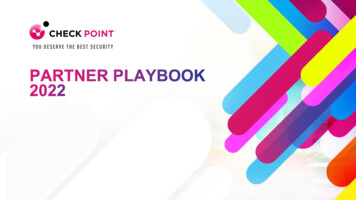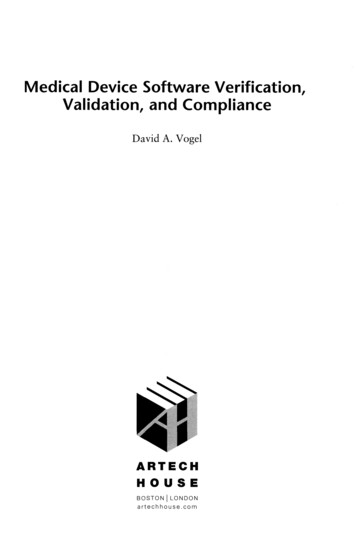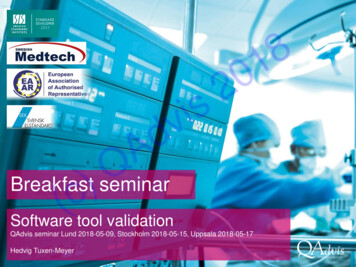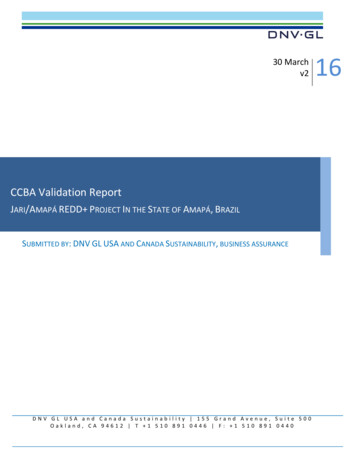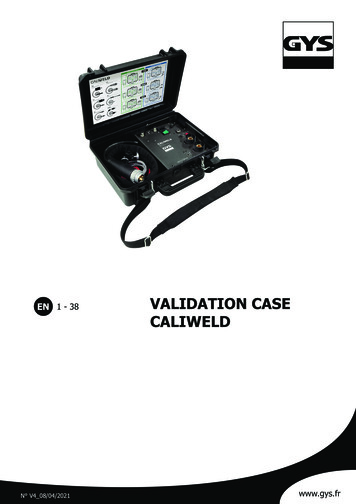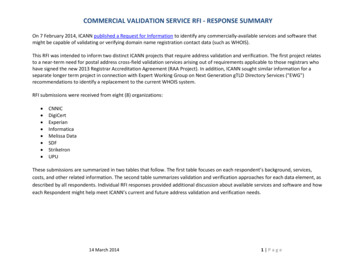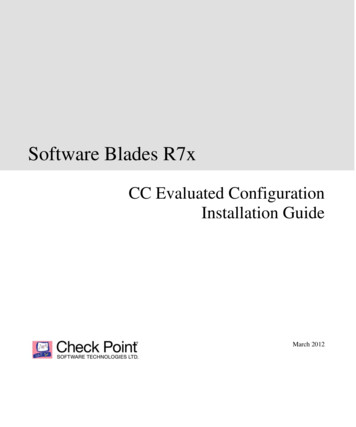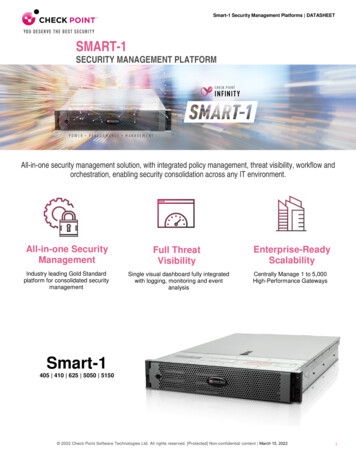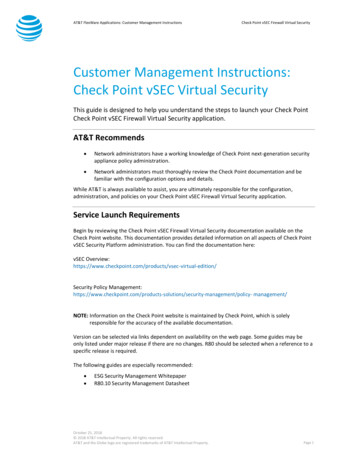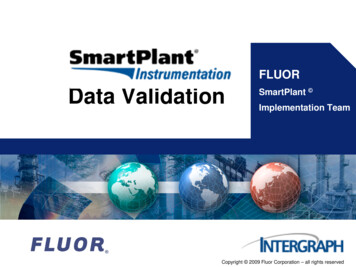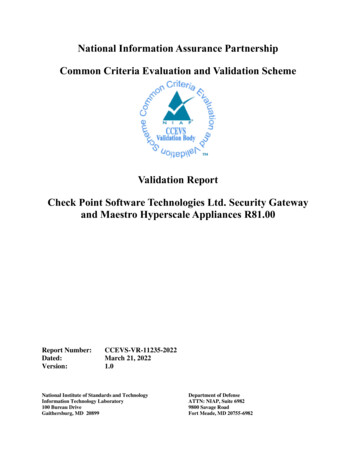
Transcription
National Information Assurance PartnershipCommon Criteria Evaluation and Validation SchemeValidation ReportCheck Point Software Technologies Ltd. Security Gatewayand Maestro Hyperscale Appliances R81.00Report Number:Dated:Version:CCEVS-VR-11235-2022March 21, 20221.0National Institute of Standards and TechnologyInformation Technology Laboratory100 Bureau DriveGaithersburg, MD 20899Department of DefenseATTN: NIAP, Suite 69829800 Savage RoadFort Meade, MD 20755-6982
Check Point Security Gateway andMaestro Hyperscale Appliances R81.00Validation ReportVersion 1.0, March 21, 2022ACKNOWLEDGEMENTSValidation TeamPaul BicknellJenn DotsonSheldon DurrantLisa MitchellBen SchmidtThe MITRE CorporationFarid AhmedJohns Hopkins University Applied Physics LaboratoryCommon Criteria Testing LaboratoryKevin CumminsEd MorrisGossamer Security Solutions, Inc.Columbia, MDii
Check Point Security Gateway andMaestro Hyperscale Appliances R81.00Validation ReportVersion 1.0, March 21, 2022Table of Contents123Executive Summary . 1Identification . 1Architectural Information . 33.1TOE Evaluated Platforms . 33.2TOE Architecture . 33.3Physical Boundaries . 44Security Policy . 44.1Security audit . 54.2Communication . 54.3Cryptographic support . 54.4User data protection . 54.5Stateful Traffic Filtering Firewall . 54.6Identification and authentication. 64.7Security management . 64.8Packet filtering . 64.9Protection of the TSF . 64.10 TOE access. 74.11 Trusted path/channels . 75Assumptions. 76Clarification of Scope . 77Documentation . 88IT Product Testing . 88.1Developer Testing . 88.2Evaluation Team Independent Testing . 89Results of the Evaluation . 99.1Evaluation of the Security Target (ASE) . 99.2Evaluation of the Development (ADV) . 99.3Evaluation of the Guidance Documents (AGD) . 99.4Evaluation of the Life Cycle Support Activities (ALC) . 109.5Evaluation of the Test Documentation and the Test Activity (ATE) . 109.6Vulnerability Assessment Activity (VAN) . 109.7Summary of Evaluation Results. 1110 Validator Comments/Recommendations . 1111 Annexes. 1112 Security Target . 1113 Glossary . 1114 Bibliography . 12iii
Check Point Security Gateway andMaestro Hyperscale Appliances R81.00Validation ReportVersion 1.0, March 21, 20221 Executive SummaryThis report documents the assessment of the National Information Assurance Partnership (NIAP)Validation team of the evaluation of Check Point Security Gateway and Maestro HyperscaleAppliances R81.00 provided by Check Point Software Technologies Ltd. It presents the evaluationresults, their justifications, and the conformance results. This Validation Report (VR) is not anendorsement of the Target of Evaluation (TOE) by any agency of the U.S. government, and nowarranty is either expressed or implied.The evaluation was performed by the Gossamer Security Solutions (Gossamer) Common CriteriaTesting Laboratory (CCTL) in Columbia, MD, United States of America, and was completed inMarch 2022. The information in this report is largely derived from the Evaluation Technical Report(ETR) and associated test reports, all written by Gossamer Security Solutions. The evaluationdetermined that the product is both Common Criteria Part 2 Extended and Part 3 Conformant andmeets the assurance requirements of the collaborative Protection Profile for Network Devices,version 2.2e, 23 March 2020 with the PP-Module for Stateful Traffic Filter Firewalls, version v1.4 Errata 20200625, 25 June 2020 and the PP-Module for Virtual Private Network (VPN)Gateways, version 1.1, 18 June 2020.The TOE is the Check Point Security Gateway and Maestro Hyperscale Appliances R81.00. TheTOE identified in this VR has been evaluated at a NIAP approved CCTL using the CommonMethodology for IT Security Evaluation (Version 3.1, Rev 5) for conformance to the CommonCriteria for IT Security Evaluation (Version 3.1, Rev 5). This VR applies only to the specificversion of the TOE as evaluated. The evaluation has been conducted in accordance with theprovisions of the NIAP Common Criteria Evaluation and Validation Scheme (CCEVS) and theconclusions of the testing laboratory in the ETR are consistent with the evidence provided.The Validation team monitored the activities of the Evaluation team, provided guidance ontechnical issues and evaluation processes, and reviewed the individual work units and successiveversions of the ETR. The Validation team found that the evaluation showed that the productsatisfies all the functional requirements and assurance requirements stated in the Security Target(ST). Therefore, the Validation team concludes that the testing laboratory’s findings are accurate,the conclusions justified, and the conformance results are correct. The conclusions of the testinglaboratory in the ETR are consistent with the evidence produced.The technical information included in this report was obtained from the Check Point SoftwareTechnologies Ltd. Security Gateway and Maestro Hyperscale Appliances R81.00 Security Target,version 0.5, March 16, 2022, and analysis performed by the Validation team.2 IdentificationThe CCEVS is a joint National Security Agency (NSA) and National Institute of Standards andTechnology (NIST) effort to establish commercial facilities to perform trusted product evaluations.Under this program, security evaluations are conducted by commercial testing laboratories calledCommon Criteria Testing Laboratories (CCTLs) using the Common Evaluation Methodology1
Check Point Security Gateway andMaestro Hyperscale Appliances R81.00Validation ReportVersion 1.0, March 21, 2022(CEM) in accordance with National Voluntary Laboratory Assessment Program (NVLAP)accreditation.The NIAP Validation Body assigns Validators to monitor the CCTLs to ensure quality andconsistency across evaluations. Developers of information technology products desiring a securityevaluation contract with a CCTL and pay a fee for their product’s evaluation. Upon successfulcompletion of the evaluation, the product is added to NIAP’s Validated Products List.Table 1 provides information needed to completely identify the product, including: The TOE: the fully qualified identifier of the product as evaluated. The ST, describing the security features, claims, and assurances of the product. The conformance result of the evaluation. The Protection Profile (PP) to which the product is conformant. The organizations and individuals participating in the evaluation.Table 1: Evaluation IdentifiersItemIdentifierEvaluation SchemeUnited States NIAP Common Criteria Evaluation and Validation SchemeTOECheck Point Security Gateway and Maestro Hyperscale Appliances R81.00(Specific models identified in Section 3.1)Protection Profilecollaborative Protection Profile for Network Devices, version 2.2e, 23 March2020 with the PP-Module for Stateful Traffic Filter Firewalls, version v1.4 Errata 20200625, 25 June 2020 and the PP-Module for Virtual Private Network(VPN) Gateways, version 1.1, 18 June 2020STCheck Point Software Technologies Ltd. Security Gateway and MaestroHyperscale Appliances R81.00 Security Target, version 0.5, March 16, 2022Evaluation TechnicalReportEvaluation Technical Report for Check Point Security Gateway and MaestroHyperscale Appliances R81.00, version 0.3, March 17, 2022CC VersionCommon Criteria for Information Technology Security Evaluation, Version 3.1,rev 5Conformance ResultCC Part 2 extended, CC Part 3 conformantSponsorCheck Point Software Technologies Ltd.DeveloperCheck Point Software Technologies Ltd.Common CriteriaTesting Lab (CCTL)Gossamer Security Solutions, Inc.Columbia, MDCCEVS ValidatorsFarid Ahmed, Paul Bicknell, Jenn Dotson, Sheldon Durrant, Lisa Mitchell, BenSchmidt2
Check Point Security Gateway andMaestro Hyperscale Appliances R81.00Validation ReportVersion 1.0, March 21, 20223 Architectural InformationNote: The following architectural description is based on the description presented in the SecurityTarget.The Target of Evaluation (TOE) is Check Point Software Security Gateway and MaestroHyperscale Appliances running software version R81.00. Throughout the remainder of thisdocument the Security Gateway appliances and the Maestro Hyperscale appliances are collectivelyreferred to as “Gateways” or “Gateway appliances”. The product family is a set of VPN Gatewayand packet filtering firewall appliances, a management appliance, and management software. Theproduct provides controlled connectivity between two or more network environments. It mediatesinformation flows between clients and servers located on internal and external networks governedby the firewalls.3.1 TOE Evaluated PlatformsBelow is a list of hardware platforms included in the evaluation. All products are runningCheckpoint version R81.00 software. All platforms are x86 based hardware. These platforms canbe installed as a Security Gateway or a Standalone (i.e., a combination of a Security ManagementServer and a Security Gateway on a single hardware platform) and all are running the R81.00software. Check Point 3600, 3800 Check Point 6200, 6400, 6600, 6700, 6900 Check Point 7000 Check Point 154**, 156** Check Point 16000, 16200, 16600 Checkpoint 26000, 28000, 28600 ESXi 7.0 (HPE D360 G10)The following Check Point “Smart-1” Security Management Servers are included in theevaluated configuration, running the same R81.00 software. The below platform and virtualizedplatform run the same software but provide Security Management Server functionality and donot operate as a Security Gateway. Smart-1 525 ESXi 7.0 (HPE D360 G10)3.2 TOE ArchitectureThe TOE consists of a family of network appliances whose primary function is to provide firewallcapabilities for filtering traffic based on packet rules. As shown in the below figure, the TOE is a3
Check Point Security Gateway andMaestro Hyperscale Appliances R81.00Validation ReportVersion 1.0, March 21, 2022distributed system with support for a security management server, allowing remote administrationover a protected IPsec connection. The TOE includes the following distributed components: a Security Management Server (labelled “Mgmt SW” in the figure below) and one or more Check Point Gateway Appliances (Hardware appliances and virtual)The administrator also uses the SmartConsole Management software client version R81.00(running on one or more administrative workstations) to manage the system.All products run Check Point version R81.00 software.3.3 Physical BoundariesThere are Check Point Security Gateway and Maestro Hyperscale Appliances as well as SecurityManagement Appliances. All platforms use the same image. The difference is mainly in hardwaremakeup and physical ports. All platforms are x86 based hardware.The SmartConsole Management GUI software is installed on a Windows workstation (Windows10 Enterprise). Authorized administrators use the GUI software or CLI to remotely manage theTOE.The TOE may be configured to interact with an external syslog server. The Orchestrator (as seenin the figure in Section 3.2) provides load balancing between the Maestro gateways; however, theOrchestrator was not evaluated and no claims are made with respect to its functionality.4 Security PolicyThis section summaries the security functionality of the TOE:1. Security audit2. Communication3. Cryptographic support4. User data protection5. Stateful Traffic Filtering Firewall4
Check Point Security Gateway andMaestro Hyperscale Appliances R81.00Validation ReportVersion 1.0, March 21, 20226. Identification and authentication7. Security management8. Packet filtering9. Protection of the TSF10. TOE access11. Trusted path/channels4.1 Security auditThe TOE generates audit logs and has the capability to store them internally or to send them to anexternal audit server. The connection between the TOE and the remote audit server is protectedwith IPsec. The TOE has a disk cleanup procedure where it removes old audit logs to allow spacefor new ones. When disk space falls below a predefined threshold (the cleanup procedure cannotkeep up with the audit collection), the TOE stops collecting audit records.4.2 CommunicationThe TOE is a distributed solution consisting of Security Gateway and Maestro HyperscaleAppliances as well as a Security Management Server. The Security Management Server canmanage one or more Security Gateways and Maestro Hyperscale Appliances.4.3 Cryptographic supportThe TOE uses the Check Point Cryptographic Library version 1.1 that has received CryptographicAlgorithm Validation Program (CAVP) certificates for all cryptographic functions claimed in theST. Cryptographic services include key management, random bit generation,encryption/decryption, digital signature, and secure hashing.4.4 User data protectionThe TOE ensures that residual information is protected from potential reuse in accessible objectssuch as network packets.4.5 Stateful Traffic Filtering FirewallThe TOE supports many protocols for packet filtering including icmpv4, icmpv6, ipv4, ipv6, tcpand udp. The firewall rules implement the SPD rules (permit, deny, bypass). Each rule can beconfigured to log status of packets pertaining to the rule. All codes under each protocol areimplemented. The TOE supports FTP for stateful filtering.Routed packets are forwarded to a TOE interface with the interface’s MAC address as the layer-2destination address. The TOE routes the packets using the presumed destination address in the IPheader, in accordance with route tables maintained by the TOE.IP packets are processed by the Check Point R81.00 software, which associates them withapplication-level connections, using the IP packet header fields: source and destination IP addressand port, as well as IP protocol. Fragmented packets are reassembled before they are processed.5
Check Point Security Gateway andMaestro Hyperscale Appliances R81.00Validation ReportVersion 1.0, March 21, 2022The TOE mediates the information flows according to an administrator-defined policy. Some ofthe traffic may be either silently dropped or rejected (with notification to the presumed source).The TOE's firewall and VPN capabilities are controlled by defining an ordered set of rules in theSecurity Rule Base. The Rule Base specifies what communication will be allowed to pass andwhat will be blocked. It specifies the source and destination of the communication, what servicescan be used, at what times, whether to log the connection and the logging level.4.6 Identification and authenticationThe TOE implements a password-based authentication mechanism for authenticating users andrequires identification and authentication before allowing access. Only the banner may bepresented before authentication is complete. The TOE supports passwords of varying length andallows an administrator to specify a minimum password length between 8 and 100 characters long.The password composition can contain all special characters as required by FIA PMG EXT.1.1.Internally, the TOE keeps track of failed login attempts and if the configured number of attemptsis met, the administrator is either locked out for a period of time or until the primary administratorunlocks the account. The local Command Line Interface (CLI) remains available when the remoteaccount is locked out.The TOE’s IPsec implementation supports Pre-Shared Keys (PSKs) and X.509 certificates (bothRSA and ECDSA) for IKE authentication.4.7 Security managementThe TOE allows both local and remote administration for management of the TOE’s securityfunctions. The TOE creates and maintains roles for configured administrators. An administratorcan log in locally to the TOE using a serial connection. The local login operates in a CLI. There isone remote administration interface that can be used once the TOE is in its evaluated configuration.The remote administration interface is executed through a Graphical User Interface (GUI) programnamed SmartConsole using a connection protected by IPsec.4.8 Packet filteringPlease see the Stateful Traffic Filtering Firewall section for a description of the TOE’s packetfiltering mechanism.4.9 Protection of the TSFThe TOE includes capabilities to protect itself from unwanted modification as well as protectingits persistent data.The TOE does not store passwords in plaintext; they are obfuscated. The TOE does not supportany command line capability to view any cryptographic keys generated or used by the TOE.The TOE only allows updates after their signature is successfully verified. The TOE updatemechanism uses ECDSA with SHA-512 and P-521 to verify the signature of the update package.6
Check Point Security Gateway andMaestro Hyperscale Appliances R81.00Validation ReportVersion 1.0, March 21, 2022The TOE’s FIPS executables are signed using ECDSA with SHA-512 and P-521. For all otherexecutables a hash is computed during system installation and configuration and during updates.During power-up the integrity of all executables is verified. If an integrity test fails in thecryptographic module, the system will enter a kernel panic and will fail to boot. If an integrity testfails due to a non-matching hash, a log is written. Also, during power-up, algorithms are tested inthe kernel and user-space. If any of these test fail, the TOE is not operational for users.The TOE protects all communications among its distributed components with IPsec.The TOE provides a timestamp for use with audit records, timing elements of cryptographicfunctions, and inactivity timeouts.4.10 TOE accessThe TOE terminates interactive sessions if the session is inactive for an administrator configuredperiod of time. The TOE also allows a session to be disconnected via a logout command. Anadministrator can configure a login banner to be displayed before authentication is completed.4.11 Trusted path/channelsThe TOE protects all communications with outside entities using IPsec communications only. TheTOE employs IPsec when it sends audit data to an audit server, and when allowing remoteadministration connections. Any protocol that is part of the distributed TOE must be protected inan IPsec connection.5 AssumptionsThe Security Problem Definition, including the assumptions, may be found in the followingdocuments: collaborative Protection Profile for Network Devices, version 2.2e, 23 March 2020 PP-Module for Stateful Traffic Filter Firewalls for Stateful Traffic Filter Firewalls,version v1.4 Errata 20200625, 25 June 2020 PP-Module for Virtual Private Network (VPN) Gateways, version 1.1, 18 June PP ND v2.2e/MOD cPP FW v1.4e/MOD VPNGW v1.1 should be consulted if there isinterest in that material.6 Clarification of ScopeThe scope of this evaluation was limited to the functionality and assurances covered in thecPP ND v2.2e/MOD cPP FW v1.4e/MOD VPNGW v1.1 and applicable Technical Decisionsas described for this TOE in the ST. Other functionality included in the product was not assessed7
Check Point Security Gateway andMaestro Hyperscale Appliances R81.00Validation ReportVersion 1.0, March 21, 2022as part of this evaluation. All other functionality provided by the devices needs to be assessedseparately, and no further conclusions can be drawn about their effectiveness.All evaluations (and all products) have limitations, as well as potential misconceptions that needclarification. This text covers some of the more important limitations and clarifications of thisevaluation. Note that: As with any evaluation, this evaluation only shows that the evaluated configuration meetsthe security claims made with a certain level of assurance (the assurance activities specifiedin the collaborative Protection Profile for Network Devices with the FW and VPNGW PPModules and performed by the Evaluation team). This evaluation covers only the specific device models and software as identified in thisdocument, and not any earlier or later versions released or in process. This evaluation did not specifically search for, nor attempt to exploit, vulnerabilities thatwere not “obvious” or vulnerabilities to objectives not claimed in the ST. The CEM definesan “obvious” vulnerability as one that is easily exploited with a minimum of understandingof the TOE, technical sophistication and resources.7 DocumentationThe following documents were available with the TOE for evaluation: Check Point Software Technologies LTD. Security Gateway Appliances R81.00 CommonCriteria Supplement, Version 1.0, March 16, 2022 Check Point Software Technologies LTD. R81.00 NIAP Installation Guide, Version 1.0,March 16, 20228 IT Product TestingThis section describes the testing efforts of the developer and the Evaluation team. It is derivedfrom information contained in the proprietary Detailed Test Report for Check Point SoftwareTechnologies Ltd. Security Gateway Appliances R81, Version 0.3, March 17, 2022 (DTR), assummarized in the evaluation Assurance Activity Report (AAR).8.1 Developer TestingNo evidence of developer testing is required in the assurance activities for this product.8.2 Evaluation Team Independent TestingThe Evaluation team verified the product according to a Common Criteria Certification documentand ran the tests specified in the cPP ND v2.2e/MOD cPP FW v1.4e/MOD VPNGW v1.1including the tests associated with optional requirements. The AAR, in sections 1.1 lists the testeddevices, provides a list of test tools, and has diagrams of the test environment.8
Check Point Security Gateway andMaestro Hyperscale Appliances R81.00Validation ReportVersion 1.0, March 21, 20229 Results of the EvaluationThe results of the assurance requirements are generally described in this section and are presentedin detail in the proprietary ETR. The reader of this document can assume that all assuranceactivities and work units received a passing verdict.A verdict for an assurance component is determined by the resulting verdicts assigned to thecorresponding evaluator action elements. The evaluation was conducted based upon CC version3.1 rev 5 and CEM version 3.1 rev 5. The evaluation determined the Security Gateway andMaestro Hyperscale Appliances TOE to be Part 2 extended, and to meet the SARs contained inthe cPP ND v2.2e/MOD cPP FW v1.4e/MOD VPNGW v1.1.9.1 Evaluation of the Security Target (ASE)The Evaluation team applied each ASE CEM work unit. The ST evaluation ensured the STcontains a description of the environment in terms of policies and assumptions, a statement ofsecurity requirements claimed to be met by the Check Point Security Gateway and MaestroHyperscale Appliances R81.00 products that are consistent with the Common Criteria, and productsecurity function descriptions that support the requirements.The Validation team reviewed the work of the Evaluation team and found that sufficient evidenceand justification was provided by the Evaluation team to confirm that the evaluation was conductedin accordance with the requirements of the CEM, and that the conclusion reached by the Evaluationteam was justified.9.2 Evaluation of the Development (ADV)The Evaluation team applied each ADV CEM work unit. The Evaluation team assessed the designdocumentation and found it adequate to aid in understanding how the TSF provides the securityfunctions. The design documentation consists of a functional specification contained in theSecurity Target and Guidance documents. Additionally, the Evaluation team performed theassurance activities specified in the cPP ND v2.2e/MOD cPP FW v1.4e/MOD VPNGW v1.1related to the examination of the information contained in the TSS.The Validation team reviewed the work of the Evaluation team and found that sufficient evidenceand justification was provided by the Evaluation team to confirm that the evaluation was conductedin accordance with the requirements of the CEM, and that the conclusion reached by the Evaluationteam was justified.9.3 Evaluation of the Guidance Documents (AGD)The Evaluation team applied each AGD CEM work unit. The Evaluation team ensured theadequacy of the user guidance in describing how to use the operational TOE. Additionally, theEvaluation team ensured the adequacy of the administrator guidance in describing how to securelyadminister the TOE. The guidance was assessed during the design and testing phases of theevaluation to ensure it was complete.9
Check Point Security Gateway andMaestro Hyperscale Appliances R81.00Validation ReportVersion 1.0, March 21, 2022The Validation team reviewed the work of the Evaluation team and found that sufficient evidenceand justification was provided by the Evaluation team to confirm that the evaluation was conductedin accordance with the requirements of the CEM, and that the conclusion reached by the Evaluationteam was justified.9.4 Evaluation of the Life Cycle Support Activities (ALC)The Evaluation team applied each ALC CEM work unit. The Evaluation team found that the TOEwas identified.The Validation team reviewed the work of the Evaluation team and found that sufficient evidenceand justification was provided by the Evaluation team to confirm that the evaluation was conductedin accordance with the requirements of the CEM, and that the conclusion reached by the Evaluationteam was justified.9.5 Evaluation of the Test Documentation and the Test Activity (ATE)The Evaluation team applied each ATE CEM work unit. The evaluation team ran the set of testsspecified by the assurance activities in the cPP ND v2.2e/MOD cPP FW v1.4e/MOD VPNGW v1.1 and recorded the results in a Test Report, summarized in the AAR.The Validation team reviewed the work of the Evaluation team and found that sufficient evidenceand justification was provided by the Evaluation team to confirm that the evaluation was conductedin accordance with the requirements of the CEM, and that the conclusion reached by the Evaluationteam was justified.9.6 Vulnerability Assessment Activity (VAN)The Evaluation team applied each AVA CEM work unit. The vulnerability analysis is in theDTR prepared by the Evaluation team. The vulnerability analysis includes a public search forvulnerabilities. The public search for vulnerabilities did not uncover any residual vulnerability.The Evaluation team searched the National Vulnerability Database(https://web.nvd.nist.gov/vuln/search), Vulnerability Notes Database(http://www.kb.cert.org/vuls/), Rapid7 Vulnerability ), Tipping Point Zero Day Initiative(http://www.zerodayinitiati
Check Point Security Gateway and Validation Report Version 1.0, March 21, 2022 Maestro Hyperscale Appliances R81.00 1 1 Executive Summary This report documents the assessment of the National Information Assurance Partnership (NIAP)
